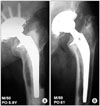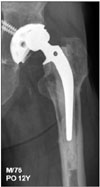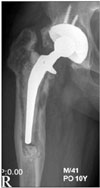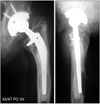Abstract
Purpose
The purpose of this study was to evaluate the 15.5 year long term survival rate of the Precoat femoral stem.
Materials and Methods
We reviewed the results of 105 primary hybrid total hip replacements (98 patients) that were performed by one surgeon between October 1990 and August 1995 using a cemented polymethyl-methacrylate coated femoral prosthesis (Precoat) and contemporary cementing techniques. Thirty four patients (34 hips) died and seventeen patients (17 hips) were lost to follow-up. Forty seven patients (54 hips) were available for clinical follow-up, with an average follow-up period of 15.5 years (range: 8.4 to 18.3 years). The average age of the patients at the time of the index operation was 46 years (range: 22 to 67 years). There were 32 male patients (37 hips) and 15 female patients (17 hips).
Results
For the acetabular component, 15 hips (27.8%) were revised for cup loosening and isolated liner exchange was performed in 12 hips (22.2%) for liner wear and osteolysis. For the femoral component, 12 hips (22.2%) were revised due to aseptic loosening. Of these twelve hips, 3 hips had Grade B cement mantles and 9 had Grade C cement mantles. The clinical results of the 54 retained hips were good or excellent in 52 hips (96.3%) with the average Harris hip score being 88 points (range: 72 to 96 points).
Conclusion
The mean 15.5 years' survival rate of the Precoat cemented femoral stem was 78%. We think that there were several factors for the failure of femoral stem fixation, including age, physical activity and the body weight, as well as the stem design and the surgical technique had an influence on the stem's survival.
Figures and Tables
References
1. Son WY, Hur CY, Moon JG, Rho YJ, Jung SH. Six to ten year follow-up study of primary hybrid total hip arthroplasty using a precoate stem. J Korean Hip Soc. 2003. 15:78–86.
2. Harris WH. Early loosening of the femoral component at the cement-prosthesis interface after total hip replacement. J Bone Joint Surg Am. 1997. 79:313–314.
3. Harris WH. Long-term results of cemented femoral stems with roughened precoated surfaces. Clin Orthop Relat Res. 1998. (355):137–143.
5. Sutherland CJ, Wilde AH, Borden LS, Marks KE. A ten-year follow-up of one hundred consecutive Müller curved-stem total hip-replacement arthroplasties. J Bone Joint Surg Am. 1982. 64:970–982.

6. Barrack RL, Mulroy RD Jr, Harris WH. Improved cementing techniques and femoral component loosening in young patients with hip arthroplasty. A 12-year radiographic review. J Bone Joint Surg Br. 1992. 74:385–389.

7. Harris WH, Davies JP. Modern use of modern cement for total hip replacement. Orthop Clin North Am. 1988. 19:581–589.

8. Dowd JE, Cha CW, Trakru S, Kim SY, Yang IH, Rubash HE. Failure of total hip arthroplasty with a precoated prosthesis. 4- to 11-year results. Clin Orthop Relat Res. 1998. (355):123–136.
9. Brown EC 3rd, Lachiewicz PF. Precoated femoral component in total hip arthroplasty. Results of 5- to 9-year followup. Clin Orthop Relat Res. 1999. (364):153–159.
11. Cannestra VP, Berger RA, Quigley LR, Jacobs JJ, Rosenberg AG, Galante JO. Hybrid total hip arthroplasty with a precoated offset stem. Four to nine-year results. J Bone Joint Surg Am. 2000. 82:1291–1299.
12. Ong A, Wong KL, Lai M, Garino JP, Steinberg ME. Early failure of precoated femoral components in primary total hip arthroplasty. J Bone Joint Surg Am. 2002. 84-A:786–792.

13. Harris WH, McCarthy JC Jr, O'Neill DA. Loosening of the femoral component of total hip replacement after plugging the femoral canal. Hip. 1982. 228–238.
14. DeLee JG, Charnley J. Radiological demarcation of cemented sockets in total hip replacement. Clin Orthop Relat Res. 1976. (121):20–32.

15. Wilson MG, Nikpoor N, Aliabadi P, Poss R, Weissman BN. The fate of acetabular allografts after bipolar revision arthroplasty of the hip. A radiographic review. J Bone Joint Surg Am. 1989. 71:1469–1479.

16. Harris WH. Is it advantageous to strengthen the cement-metal interface and use a collar for cemented femoral components of total hip replacements? Clin Orthop Relat Res. 1992. (285):67–72.

17. Harris WH, McCarthy JC Jr, O'Neill DA. Femoral component loosening using contemporary techniques of femoral cement fixation. J Bone Joint Surg Am. 1982. 64:1063–1067.

18. Goldberg VM, Ninomiya J, Kelly G, Kraay M. Hybrid total hip arthroplasty: a 7- to 11-year followup. Clin Orthop Relat Res. 1996. (333):147–154.
19. Clohisy JC, Harris WH. Primary hybrid total hip replacement, performed with insertion of the acetabular component without cement and a precoat femoral component with cement. An average ten-year follow-up study. J Bone Joint Surg Am. 1999. 81:247–255.

20. Ito H, Matsuno T, Minami A. Pre-coated femoral components in hybrid total hip arthroplasty. Results at 11 years. J Bone Joint Surg Br. 2005. 87:306–309.
21. Mulroy WF, Estok DM, Harris WH. Total hip arthroplasty with use of so-called second-generation cementing techniques. A fifteen-year-average follow-up study. J Bone Joint Surg Am. 1995. 77:1845–1852.

22. Lachiewicz PF, Messick P. Precoated femoral component in primary hybrid total hip arthroplasty: results at a mean 10-year follow-up. J Arthroplasty. 2003. 18:1–5.

23. Gardiner RC, Hozack WJ. Failure of the cement-bone interface. A consequence of strengthening the cement-prosthesis interface? J Bone Joint Surg Br. 1994. 76:49–52.

24. Harrington MA Jr, O'Connor DO, Lozynsky AJ, Kovach I, Harris WH. Effects of femoral neck length, stem size, and body weight on strains in the proximal cement mantle. J Bone Joint Surg Am. 2002. 84-A:573–579.

25. Ebramzadeh E, Sarmiento A, McKellop HA, Llinas A, Gogan W. The cement mantle in total hip arthroplasty. Analysis of long-term radiographic results. J Bone Joint Surg Am. 1994. 76:77–87.

26. Macpherson GJ, Hank C, Schneider M, Trayner M, Elton R, Howie CR, Breusch SJ. The posterior approach reduces the risk of thin cement mantles with a straight femoral stem design. Acta Orthop. 2010. 81:292–295.

27. Haydon CM, Mehin R, Burnett S, et al. Revision total hip arthroplasty with use of a cemented femoral component. Results at a mean of ten years. J Bone Joint Surg Am. 2004. 86-A:1179–1185.




 PDF
PDF ePub
ePub Citation
Citation Print
Print






 XML Download
XML Download